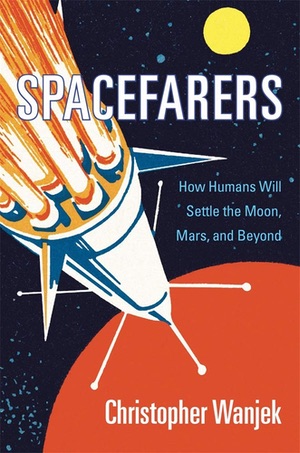Review: Spacefarersby Jeff Foust
|
| Wanjek starts the book in a way that leads you to think he is advocating against human spaceflight. |
The latest attempt in that long-running effort to make a case for human spaceflight is Spacefarers by Christopher Wanjek, a science writer whose career includes both stints at NASA as well as a joke writer for Jay Leno on The Tonight Show. The book’s subtitle claims he will chart a path for how humans will go beyond the Earth. But, while the book examines a range of technical approaches for human spaceflight, it comes up short explaining why they’re worth doing.
Wanjek starts the book in a way that leads you to think he is advocating against human spaceflight. The first chapter notes that the Earth is far more habitable than any other destination in the solar system, and criticizes some of the rationales offered for human settlement. Overpopulation? No, space settlement can’t realistic offer a relief valve, he argues. Ensuring survival of the species, as people like Elon Musk have argued? No, he counters, there’s no realistic scenario for the foreseeable future where all of humanity would be wiped out by a natural or human-made calamity. A second chapter then examines the health issues associated with spaceflight, from the deleterious effects of weightlessness to exposure to solar and cosmic radiation.
After reading those two chapters, you might believe that Wanjek is making a strong case for humans to stay home and let robots do our bidding in space. However, he follows that introduction with chapters that examine the potential roles for humans in Earth orbit, the Moon, asteroids, and Mars. (A final chapter even extends that to other destinations in both the inner and outer solar system, albeit must further into the future.) He examines in depth the technical details and issues associated with sending humans to these destinations.
While Wanjek is skeptical of some near-term initiatives, like NASA’s Artemis program to return humans to the Moon by 2024, he paints a surprisingly optimistic view about humanity’s future in space. His predictions, at the end of each chapter, range from space hotels by 2030 to a permanent human presence for “small science and mining camps” on the Moon in the 2030s to a Mars base in the 2050s. Those timelines might be longer than what some space advocates, like fans of Musk, might want, but it’s still quite optimistic given all of the problems with human spaceflight he outlined earlier in the book.
One problem, though, is that it’s never quite clear what those people would be doing in space that actually requires the presence of humans (beyond, of course, space tourism.) For the Moon, he suggests humans will be needed for mining, and goes so far to predict that those bases will be like mining settlements on Earth, “predominantly male” and potentially a “lawless boomtown.” But the business case for mining—he suggests helium-3 and rare earth elements—is unclear, and the high costs and hostile conditions of any lunar mining efforts would likely emphasize robotic, remote operations, just as is taking place today in some terrestrial mining projects. In other words, it may be more like Moon than Outland.
To support human missions to Mars, Wanjek tries to conjure up a space race between China and the United States, something he does to a lesser extent in the chapter about the Moon. “China has a plan to establish human colonies on Mars by the 2040s,” he claims, but doesn’t cite evidence of that. That plan apparently includes “simultaneously sending seven orbiters and six rovers by the early 2020s, almost all at once.” Yet there is no evidence of such a bold plan. China is sending a Mars mission this summer with an orbiter, lander, and rover—ambitious in and of itself—but there’s no sign it is a vanguard of a fleet that would have to launch in 2022 and/or 2024.
| To support human missions to Mars, he tries to conjure up a space race between China and the United States. “China has a plan to establish human colonies on Mars by the 2040s,” he claims, but doesn’t cite evidence of that. |
There are other factual flaws in the book. He claims that SpaceX has been able to turn around boosters and refly them with 48 hours; turnaround time has so far been closer to a couple months than a couple days. He says the government of Luxembourg has invested “hundreds of millions of dollars” in asteroid mining; its investment in Planetary Resources, its biggest investment in that sector, was just a small fraction of that and effectively wiped out when the company was sold to ConsenSys. (He also doesn’t mention the other major asteroid mining startup, Deep Space Industries, pivoted to smallsat work and was later acquired.) He says NASA will send people to Mars “in a spacecraft now under development called Orion”; the agency, of course, is not considering forcing a crew to remain in the cramped Orion capsule for the entire journey there and back.
In some respects, Spacefarers still lives up to its subtitle, as it does go into significant detail about how humans can go and live on other worlds. But “how” has never really been the problem: there’s no shortage of ideas about going to the Moon, Mars, or elsewhere, each with its particular advantages and disadvantages. The difficulty is answering the “why” question, be it with a rationale compelling enough to win political support or a business case compelling enough to win investment. After this book, that’s still a difficult question to answer.
Note: we are temporarily moderating all comments submitted to deal with a surge in spam.
